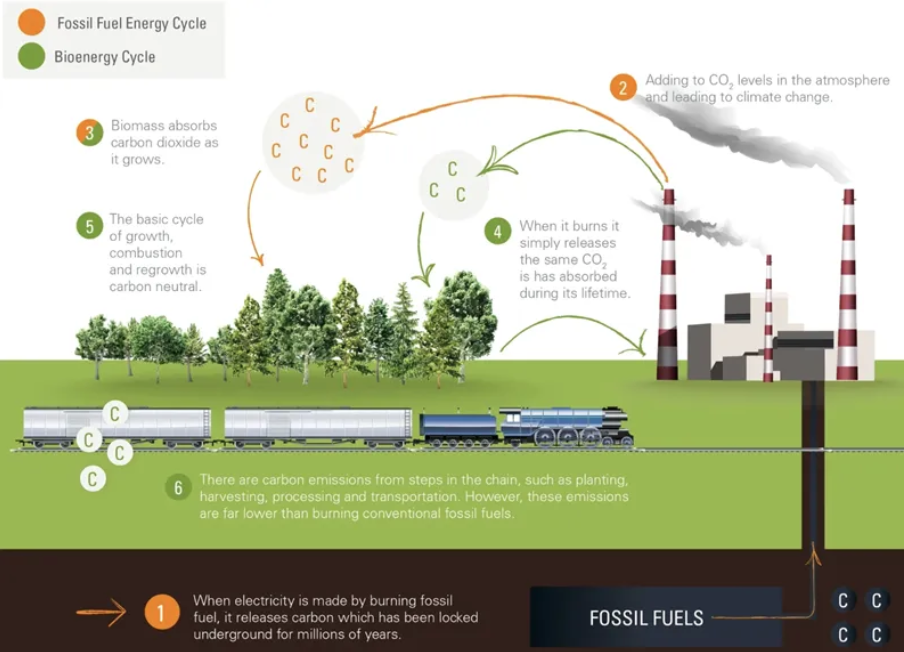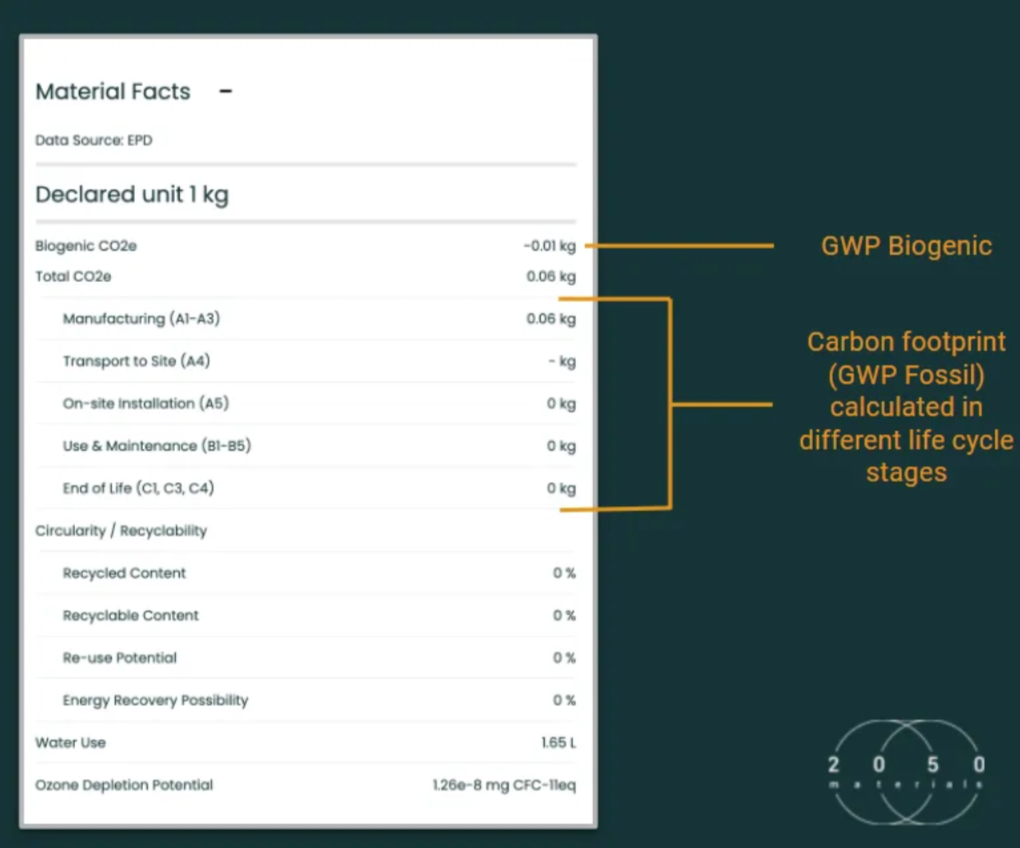Biogenic Carbon — What it is and how is it accounted
What is biogenic carbon?
With the attention on carbon emissions caused by anthropogenic activity, one often forgets that carbon is a naturally occurring element of the Earth’s atmosphere with a natural cycle of its own. Biogenic carbon is an integral part of this natural carbon cycle and is referred to the carbon that is stored in, sequestered, and released by organic matter.
Carbon is added to plants and trees, throughout their lifetime due to the process of photosynthesis and the stored carbon is released as a result of either decomposition or combustion at the end of the plant’s life cycle. These emissions that occur as a result of decomposition or combustion of biomass are known as biogenic carbon emissions.
On the other hand, non-biogenic carbon is the carbon that is not derived from biomass and most commonly is referred to as carbon that is stored in fossil fuels. Combustion of fossil fuels amount to significant carbon emissions and those that take a long time to be reabsorbed.

Biogenic carbon cycle works on a much faster timeline as compared to non- biogenic carbon cycle, as biogenic carbon stored in plants and trees has a cycle of about 100 years and that stored in soil about half a millennium. Whereas, carbon stored in fossil fuels can have a cycle of over 10,000 years.
Carbon accounting practices
As carbon accumulates in trees and plants over their lifecycle, biomass can act as a catalyst for mitigating the impact of climate change. Biogenic carbon stored in bio- based products that can be used as building materials, therefore can be counted as negative emissions. Carbon emissions emanating from combustion of renewable materials are not considered to be included in GWP as per most Life Cycle Analysis (LCA) methodologies including CML, EN 15978, TRACI. This is because these materials are considered to grow back within a few decades and help in accounting for carbon that was emitted considering that the forest area remains unchanged.
The carbon will be stored in the bio-based product, used as a building material till the building reaches its end of life. The stored carbon in these materials is emitted back to the atmosphere at the end-of-life accounting for a net zero total carbon over the lifespan of the building.
The principles for biogenic carbon accounting are defined in the international standard, ISO 21930, which is the governing body for EPDs for construction materials and products.
ISO 21930 states that the biogenic carbon entering a system is considered as reduction in emissions and is “characterized with a factor of -1”. It implies carbon drawdown from the atmosphere as a result of carbon accumulating in biomass. Burning or decomposition of the material leads to release of some of the stored carbon into the atmosphere and is “characterized with a factor of +1”. Correspondingly, biogenic carbon leaving a system is considered as carbon emissions. In simple words, this means that biogenic carbon is accounted as a negative value when it enters a system and as a positive value when it leaves a system. Designers consider the ISO 21930 accounting principle and take -1/in and +1/out for accounting for biogenic carbon in building materials.
How is biogenic carbon reported in LCA and EPDs?
Two different approaches can be identified for assessment of biogenic carbon in Life Cycle Analysis (LCA) conducted for buildings. The first one which is referred to as the “carbon neutral approach” or the “0/0 approach” is built on the hypothesis that the amount of carbon uptake during the growth of biomass is equivalent to the amount of carbon released at the end of life of the bio-based material. This leads to a balance in the amount of carbon uptake and release.
The other approach which is referred to as the “-1/+1 approach” takes into account all biogenic carbon flows of a building through its entire life cycle. When a bio-based building material is used, the stored biogenic carbon in the biomass enters the building system and is reported as negative emission. A positive emission is accounted at the end of the life of the building when either the biogenic carbon is released back into the atmosphere or further transferred to another building system. In these two scenarios, a positive emission is accounted for in Life cycle stage C. The advantage of the -1/+1 approach over the 0/0 approach is that it provides an overview of biogenic carbon flows but there could be misleading results with only the impact of the material life cycle stages of production and construction with uptake of biogenic carbon is taken into account and not release at the end-of-life cycle.
Another school of thought is that the LCA approaches do not take into account the “timing of carbon emissions” and impact of rotation periods of biomass growth. For example, trees are considered to have longer rotation periods and cannot be considered as carbon neutral in a short time span whereas materials such as straw are fast growing and hence have a shorter rotation period and can be more effective towards carbon removal from the atmosphere.
How is biogenic carbon reported in EN 15804+A1 and the changes in EN 15804 + A2
In EN 15804 +A1, it was feasible to account for biogenic carbon stored in a product only if it was sourced from a sustainably run forest, calculating the cradle to gate impact, and then summing them to signify their release at the end-of-life stage. The revised EN 15804 + A2 EPD standard states that the biogenic carbon mass of a product and for the packaging has to be declared.
Previously, reported as a single number, GWP — Global Warming Potential would not differentiate between biogenic, fossil, land use classification which is now divided into four different categories in the revised version. These include:
· GWP total (total of subgroups)
· GWP fossil
· GWP biogenic
· GWP luluc (land use and changes)

Reporting of biogenic carbon is only optional when the materials containing biogenic carbon constitute less than 5% of the total product and packaging material.
How is biogenic carbon reported in 2050 Materials?
On our platform, the biogenic carbon stored in a product is accounted and represented as an additional information to expand on the environmental impact data of the product. Biogenic carbon is accounted for the whole life cycle stages of a product including production (A1-A3), on-site installation (A5), use and maintenance (B1-B5), and end-of-life stage (C1, C3, C4). Stages A4 ( Transport to site) and C2 ( Transport — end of life) are excluded from calculations because of a lack of accuracy of data but will be added as we expand the platform to take into account the construction site location.

The calculations are based on data sourced from EPDs of the product. If the biogenic carbon is not declared in the EPD, then the carbon (GWP total) is calculated for the whole life cycle stages — (A1-A3) production, (A5) installation, (B1-B5) use stage and (C1, C3, C4) end-of-life stage. When a product has biogenic carbon declared in the EPD, we account for the fossil-based carbon for the whole life cycle stages separately and biogenic carbon is accountedfor separately tracking the uptake and release of carbon for the entire life cycle.
The negative emissions from storing the carbon are accounted for in stages (A1-A3) and in stage C3, the carbon is released back into the atmosphere if the product’s end of life/waste processing stage is incineration or landfilling.
For any questions or suggestions to help us improve our approach, reach out to us at info@2050-marerials.com
The 2050 Materials team
Related articles

Climate-Resilient Materials for the Built Environment: A Data-Centred Prime
As climate volatility intensifies, resilience metrics are fast becoming as critical as carbon data in material selection. This article outlines why adaptation is now a design imperative, how materials can be evaluated through a systems lens, and what KPIs project teams should demand. From self-healing concrete to fire-rated façades, we present a structured taxonomy of resilient materials, explain how to embed this intelligence into digital design workflows, and propose next steps for specification, benchmarking, and procurement.
Read more
The Most Interesting Low Carbon Products in Office Design
In this article and collection, we highlight 11 outstanding products that contribute to a lower carbon footprint in office design.
Read more
Top Low Carbon Building Boards: Performance, Benefits, and Use Cases
The building boards highlighted in this article and collection showcase low-carbon innovation in modern construction.
Read more